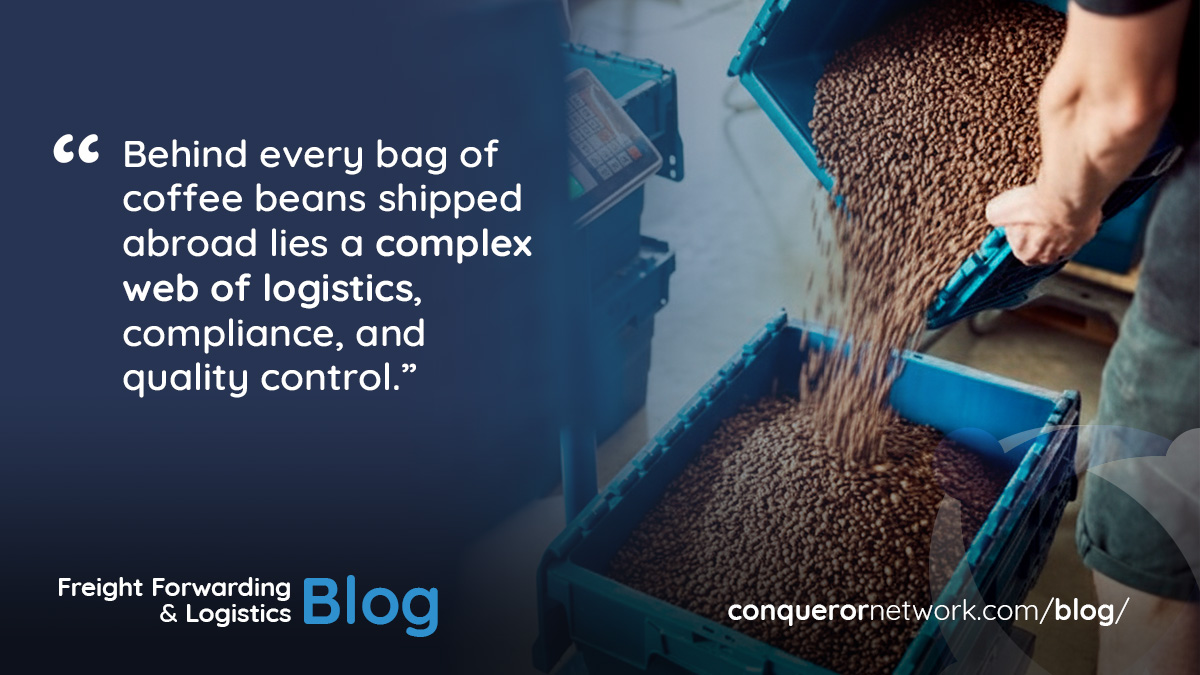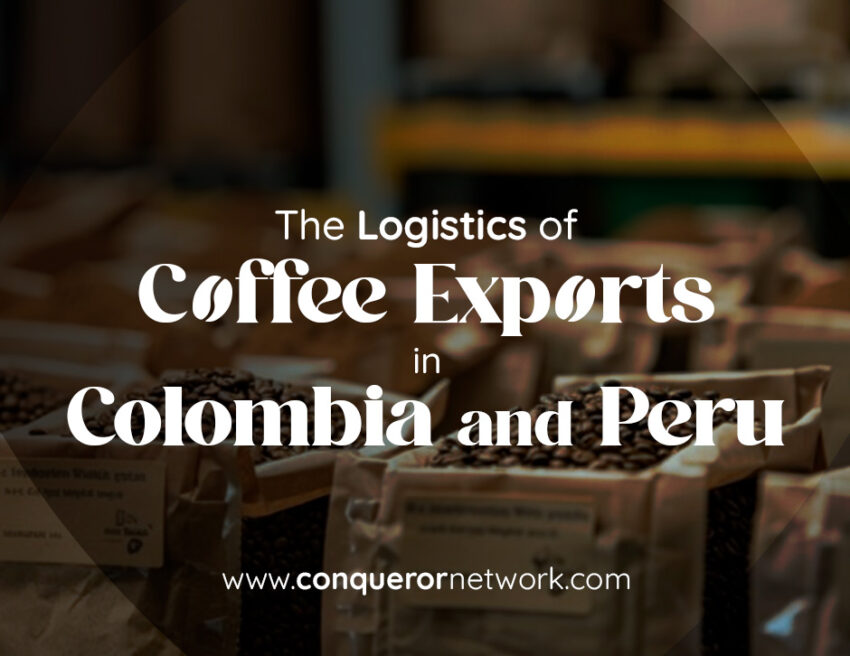Coffee is more than just a morning ritual; it’s one of the most valuable commodities in international trade. For countries like Colombia and Peru, coffee exports form a cornerstone of the economy, supporting millions of smallholder farmers while fueling the global coffee industry. Behind every bag of coffee beans shipped abroad lies a complex web of logistics, compliance, and quality control. Understanding the nuances of coffee logistics in these two South American powerhouses is essential for freight forwarders, exporters, and anyone involved in the international coffee trade.
Understanding Coffee Exports in Colombia and Peru
Colombia and Peru share a reputation for producing high-quality Arabica beans, but the scale and structure of their coffee exports differ. Colombia coffee exports are traditionally larger in volume and heavily associated with well-known global brands. Peru coffee exports, while slightly smaller, have been growing steadily, particularly in specialty and organic coffee segments.
For freight forwarders, this distinction matters. Colombia’s coffee supply chain is highly organized, with established routes to major ports like Buenaventura on the Pacific coast. In contrast, Peru’s coffee exporters often operate from multiple regions, such as Cajamarca, Cusco, and Junín, requiring diversified logistics planning. The differences between Colombia and Peru coffee exports affect shipping schedules, cost structures, and risk management strategies.

Coffee Logistics: From Farm to International Markets
The journey of coffee beans from farm to global markets involves multiple stages. It starts with harvesting ripe coffee cherries, followed by processing methods such as wet or dry milling. The resulting green coffee beans are then carefully sorted and graded. For both Colombia and Peru, maintaining quality during this phase is critical, as it directly influences market prices and buyer confidence. Once processed, coffee bean logistics becomes a matter of efficiency and precision. Temperature control for coffee exports is paramount. Green coffee beans are sensitive to humidity and temperature fluctuations, which can affect flavor and shelf life. Freight forwarders specializing in coffee logistics and transportation must ensure containers are kept under optimal conditions during transit, whether shipping from Colombia to the USA or from Peru to Europe.
Coffee export documentation requirements are another key consideration. Both countries mandate specific certificates, including phytosanitary certificates, export permits, and quality assurance documentation. Ensuring compliance with these requirements minimizes delays in international coffee shipping and avoids penalties that could affect the profitability of coffee exporters.
How Coffee Supply Chain Management Shapes Export Success
Efficient coffee supply chain management is all about creating a reliable, transparent, and traceable network. This includes inventory management, freight forwarding for coffee beans, coordination with shipping lines, and adherence to international coffee shipping standards. Freight forwarders must also navigate the complexities of coffee import logistics in destination countries, managing customs clearance and understanding coffee bean shipping regulations.
The coffee export process in Peru and Colombia also emphasizes quality control during shipping. Sampling at different points along the supply chain ensures beans meet the expected standards. Logistics partners play a pivotal role in monitoring temperature, humidity, and handling procedures during storage and transit. Best practices for coffee logistics often involve real-time tracking, predictive risk management, and collaboration with certified coffee exporters to maintain consistency.
Key Differences Between Colombia and Peru Coffee Exports
When comparing coffee exports in Colombia and Peru, several differences stand out. Colombia coffee exports benefit from larger-scale operations, established international networks, and strong branding. This makes Colombia a top supplier for bulk orders and for markets demanding consistent quality. In contrast, Peru coffee exports lean heavily into specialty and organic markets. While volumes are smaller, the demand for premium products allows exporters to command higher prices, especially in the European and North American markets.
These differences also affect coffee logistics strategies. Freight forwarding for Colombia often involves high-volume shipments, consolidated loads, and long-term partnerships with carriers. Peru’s coffee bean logistics, meanwhile, can require more flexible routing, smaller shipments, and specialized handling for organic or single-origin batches. Understanding these differences helps freight forwarders provide tailored solutions, optimizing cost, transit time, and quality preservation.
Step-by-Step: Exporting Coffee from Colombia and Peru
For freight forwarders assisting coffee exporters, knowing how to export coffee from Colombia or manage the coffee export process in Peru is critical. Here’s a simplified outline:
-
Harvesting and Processing: Coffee cherries are collected and processed into green beans. Exporters must adhere to local quality standards.
-
Grading and Certification: Beans are sorted by size and quality. Certificates such as the phytosanitary certificate, COFFEECERT (in Colombia), or organic certification (in Peru) are obtained.
-
Packaging: Beans are packed in moisture-proof bags or containers. Temperature and humidity control are critical for maintaining flavor integrity.
-
Freight Forwarding and Transportation: Containers are moved to ports for international coffee shipping. Freight forwarders coordinate with shipping lines and ensure compliance with coffee bean shipping regulations.
-
Customs and Documentation: Export documentation, including invoices, permits, and certificates, is submitted to ensure smooth clearance at both origin and destination.
-
Delivery to International Markets: Beans are transported to roasters, distributors, or direct buyers. Real-time tracking and supply chain management help mitigate risks during transit.
Understanding these steps allows freight forwarders to guide coffee exporters effectively, ensuring timely deliveries and minimizing spoilage or delays.
Challenges in Coffee Export Logistics
Shipping coffee internationally is not without its challenges. Temperature fluctuations, humidity, and improper handling can degrade the quality of green coffee exports. Additionally, international coffee trade regulations vary by country, requiring careful attention to coffee import logistics, tariffs, and customs procedures. Freight costs, fluctuating shipping schedules, and geopolitical factors further complicate coffee logistics and transportation.
Costs of importing coffee beans, container availability, and port congestion can impact both the exporter and the buyer. For example, shipping from Colombia to the USA might involve specific carrier requirements, while Peru’s specialty coffee shipments may demand smaller, more frequent deliveries with precise timing to maintain quality. Best practices for coffee logistics often involve investing in quality monitoring systems, partnering with experienced freight forwarders, and maintaining strong communication with international buyers. This reduces the risk of damage, delays, or regulatory non-compliance.
Why Freight Forwarders Should Focus on Coffee Logistics
Coffee exports in Colombia and Peru present unique opportunities for freight forwarders. Specializing in coffee logistics and supply chain management allows companies to offer value-added services such as:
-
Temperature-controlled transport
-
Coffee quality control during shipping
-
Customized freight forwarding solutions for bulk or specialty orders
-
Compliance with coffee export documentation requirements
-
Guidance on coffee bean shipping regulations
By mastering these areas, freight forwarders can differentiate themselves in the competitive international coffee shipping market and build long-term relationships with coffee exporters.
Unlocking Global Opportunities with Conqueror Freight Network
Here’s the thing: logistics in Colombia and Peru is thriving, but success in the international coffee trade often depends on strong partnerships. Freight forwarders in these countries can gain a competitive edge by joining the Conqueror Freight Network. Membership provides access to vetted partners across the globe, reliable shipping routes, and opportunities for collaboration on complex shipments.
For coffee exporters, this means smoother international coffee shipping, more efficient coffee supply chain management, and better risk mitigation. With over 260 trusted and vetted partners from 134 countries around the world, logistics companies are able to cooperate reciprocally and securely to expand their businesses, reduce costs and risks, and compete on more equal terms against the largest international companies.
By joining a network like Conqueror, logistics companies can offer clients seamless solutions, leverage global connections, and participate in international coffee trade with confidence. This subtle, yet strategic advantage can help companies expand their reach without increasing operational overhead, providing a clear path to growth in both established and emerging coffee markets.
Conclusion
The logistics of coffee exports in Colombia and Peru is a finely tuned operation that requires expertise, precision, and a deep understanding of the coffee supply chain. From green coffee exports to international coffee shipping, every step demands careful coordination, temperature control, and adherence to regulatory requirements. Freight forwarders who master coffee logistics and transportation, understand coffee export documentation requirements, and maintain strong quality control during shipping can help exporters succeed in global markets.
Colombia coffee exports and Peru coffee exports may differ in scale and specialty focus, but both rely on skilled logistics partners to move their product safely and efficiently. By focusing on coffee supply chain management, embracing best practices for coffee logistics, and connecting with global partners through networks like Conqueror Freight Network, freight forwarders can position themselves as essential players in one of the world’s most beloved industries.
Coffee is not just a product, it’s a journey from farm to cup. And behind every successful journey is a logistics team that knows how to navigate the complexities of international coffee trade with precision and care.


